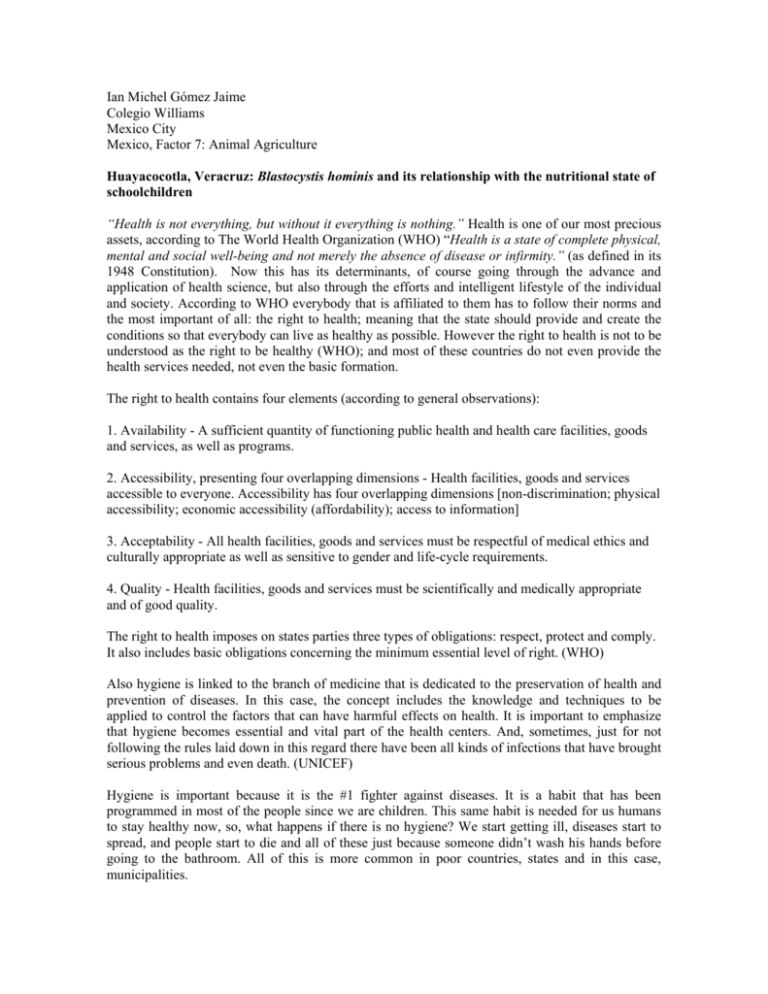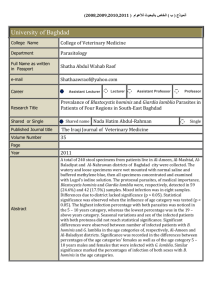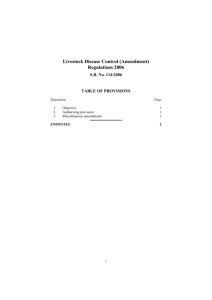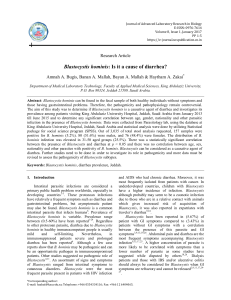Ian Michel Gomez - The World Food Prize
advertisement

Ian Michel Gómez Jaime Colegio Williams Mexico City Mexico, Factor 7: Animal Agriculture Huayacocotla, Veracruz: Blastocystis hominis and its relationship with the nutritional state of schoolchildren “Health is not everything, but without it everything is nothing.” Health is one of our most precious assets, according to The World Health Organization (WHO) “Health is a state of complete physical, mental and social well-being and not merely the absence of disease or infirmity.” (as defined in its 1948 Constitution). Now this has its determinants, of course going through the advance and application of health science, but also through the efforts and intelligent lifestyle of the individual and society. According to WHO everybody that is affiliated to them has to follow their norms and the most important of all: the right to health; meaning that the state should provide and create the conditions so that everybody can live as healthy as possible. However the right to health is not to be understood as the right to be healthy (WHO); and most of these countries do not even provide the health services needed, not even the basic formation. The right to health contains four elements (according to general observations): 1. Availability - A sufficient quantity of functioning public health and health care facilities, goods and services, as well as programs. 2. Accessibility, presenting four overlapping dimensions - Health facilities, goods and services accessible to everyone. Accessibility has four overlapping dimensions [non-discrimination; physical accessibility; economic accessibility (affordability); access to information] 3. Acceptability - All health facilities, goods and services must be respectful of medical ethics and culturally appropriate as well as sensitive to gender and life-cycle requirements. 4. Quality - Health facilities, goods and services must be scientifically and medically appropriate and of good quality. The right to health imposes on states parties three types of obligations: respect, protect and comply. It also includes basic obligations concerning the minimum essential level of right. (WHO) Also hygiene is linked to the branch of medicine that is dedicated to the preservation of health and prevention of diseases. In this case, the concept includes the knowledge and techniques to be applied to control the factors that can have harmful effects on health. It is important to emphasize that hygiene becomes essential and vital part of the health centers. And, sometimes, just for not following the rules laid down in this regard there have been all kinds of infections that have brought serious problems and even death. (UNICEF) Hygiene is important because it is the #1 fighter against diseases. It is a habit that has been programmed in most of the people since we are children. This same habit is needed for us humans to stay healthy now, so, what happens if there is no hygiene? We start getting ill, diseases start to spread, and people start to die and all of these just because someone didn’t wash his hands before going to the bathroom. All of this is more common in poor countries, states and in this case, municipalities. In the municipality of Huayacocotla, Veracruz (México), families are composed of four persons, having a total population of 20,765 in 2010, having a total of 5,237 homes in total from which 1,258 of them were led by single women like heads of the household. (SEDESOL) The medical units in the municipality were 17 (1% of medical units in the entire state), leaving a poor amount of people able to attend ill people. In 2010 16,452 individuals (78% of the total population) lived in poverty, of which 6,756 (32%) were in extreme poverty, having almost enough resources to even maintain themselves. In the same year the proportion of people without access to health services was 47.6% equivalent to 10,052 people, having the majority of the population without these services, not complying with their right to health, that is having access to these services. (SEDESOL) In Huayacocotla the highest rates of malnutrition are presented primarily in children under 5 years old, women in reproductive age and older adults. The incidences of malnutrition problems in their 3 classifications (mild moderate and severe) are unfortunately high, A series of stool lab analysis studies held with 100 schoolchildren between 6 and 14 from the Primary School in Teximalpa, Sierra de Huayacocotla was carried out. Their nutritional state was analyzed using Body Mass Index (BMI) and the application of a questionnaire. The prevalence of Blastocystis hominis was 80% it should be noted that its presence in the thinnest children was higher. (Supervision Escolar) It is clear that Blastocystis hominis affects BMI but its effect is synergic when associated with E. histolytica, E. nana, I. büestchlii and E. coli. The significant presence of protozoa transmitted by feces is an indicator of the deficiencies in the health environment of the population. In order to improve the development of the children it is imperative that we pay greater attention to the marginal communities. (UNAM); (Mayo Clinic) Blastocystis hominis is defined as: the intestinal unicellular eukaryote that is reported more frequently in stool studies; besides being a common inhabitant of the human intestinal tract, it is colonizing the intestinal tract of other primates, a wide variety of mammals, birds, amphibians, reptiles, fish, annelids and anthropoids, emphasizing its worldwide distribution and its zoonotic potential. (UNAM) The parasite exhibits a high genetic diversity. Host specificity seems to have some relationship with subtype. So far 17 subtypes have been identified, of which ST1 to ST8 colonize/infect humans and other hosts, ST9 only colonizes humans, and ST10 to ST17 have only been identified in other hosts. (Subhash Chandra Parija) Humans are infected more often with ST3 subtype, but also there are some identified regularly infections with ST1, ST2 and ST4 subtypes; the remaining cause sporadic infection. The association between subtypes of Blastocystis hominis and clinical manifestation causes controversy, although there is some evidence to suggest that is pathogenic. The parasite transmission is fecal – oral, through contaminated water and food and through contact with infected animals: domestic, wildlife, livestock and zoo. Some studies suggest that the pathogenicity of Blastocystis hominis is associated with different subtypes and the parasite load, but there are reports of clinical manifestations with a low number of parasites, and subtype is not the only factor to consider. (UNAM); (Shanthi) Possible clinical events: Asymptomatic colonization Abdominal pain Diarrhea Flatulence Anorexia Abdominal distension Rash In immunocompetent individuals, immunocompromised children Reports of chronic conditions Irritable bowel syndrome Iron deficiency anemia Chronic angioedema Palmoplantar pruritus (UNAM); (Shanthi) So one strategy that will cease the increment of bad nutritional state of these schoolchildren and stop it, is the implementation of agrosilvopastoral systems (collective name for land use systems involving the combination or deliberate association of Woody components with crops and animal husbandry in the same site) in the livestock production, improving animal health therefore diminishing the presence of the infectious subtypes of Blastocystis hominis, stopping the spread of the parasite, having as a result the absence of Blastocystis hominis in the environment, causing a great impact in the nutritional state of the municipality in general. The agrosilvopastoral systems will improve the hygiene in the livestock causing a chain reaction killing the parasite and stopping it from further spread; being a well-known phenomenon by the producers in an empirical way, strategy modified by different interpretations throughout time, which in Latin-America its implementation has been impulse since approximately thirty years ago, this has been done through different research and educational institutions by the importance and experiences of these systems to improve not only animal production but also their contribution to the restoration of degraded soil. (EcuRed) The agrosilvopastoral systems, refer to the integrated management of all production processes within the production unit, just as the practice of conservation related to the improved use of natural resources, as an area of scientific knowledge, they are a combination of traditional and modern technologies that have been systematized in order to provide a viable economic and environmentally sustainable alternative to the extensive cattle raising. (Gutierrez) Some frequent interactions between some components of the agrosilvopastoral systems: Trees provide a favorable microclimate for the animals (shade and decrease in temperature). The magnitude of the shading depends on the number of trees per unit area, the diameter of the cups and their foliage. The shadow protects the animal from overheating by direct sunlight and reduces the environmental temperature (Bovine ~ 50 – 59 °F/Ovine ~ 55 – 59 °F), which is related to the heat balance of the animal; lower body temperature results in increased consumption; although it is disputed whether it is also greater animal production. (EcuRed) Some of the factors that favor the presence of livestock in the agrosilvopastoral systems: • Small producers with limited area can produce forest food of animal origin (milk, meat) without sacrificing the area devoted to crops. The diversification of supplies flowing from work and the nature of the products of the farm system is thus achieved. • In addition to the direct benefits, producers can obtain economic benefits resulting from the firewood, grasses, wood and fodder. The last three are of any use for the benefit of the livestock component. • Livestock allows the use and control of grasses and weeds that compete with the development of juvenile trees. In the case of fruit trees or palms, the cleaning work the cattle do on the pasture facilitates fruit harvest. • In the case of livestock with crop associations, the main advantage is that it can be used in livestock feed between 60 and 70% of the plant biomass without causing competition with human food. • Grazing vegetation cover reduces the risk of fire. All of this gives producers control over their livestock and food, giving them some advantage to avoid some rough times, improving the quality and the value of their products; also it helps them to restore their degraded soil, obviously leaving aside the use of human food like animal food. The drastic reduction of forested areas along with increasing demand for forest products worldwide lead to a paradigm in the production and supply of forest products. In this context, the agrosilvopastoral systems should be considered as a palliative for domestic supply and communal tree resources in an ecological, economic and social framework. In this context, the agrosilvopastoral systems could be considered as a set of conservation practices related with the exploitation of natural resources, complementary to livestock activities already being carried out on a farm or region. Warrants considered from this point of view these practices can be used in various conditions but not only in eco-productive conditions, but also socioeconomic conditions, as practiced at different levels, from large commercial tree plantations including livestock grazing to animals to supplement subsistence agriculture. In the context of sustainable agriculture, the SASP should be considered a biological strategy in the pursuit of sustainability. (EcuRed) Now Huayacocotla livestock has an area of 10,487 hectares dedicated to cattle, where 1,893 units of rural production, breeding activity and exploitation of animals are located. It has 3,400 head of cattle dual purpose, in addition to breeding pigs, sheep, goats and horses. Poultry and bee farms have certain importance. (EcuRed) It is imperative that the government helps with water management by ensuring the supply of drinking water, either piped or water sanitization system, without any of this the proposal won’t be a viable solution neither it will function. The Chapingo university will be in charge to teach them everything about livestock and the agrosilvopastoral systems. This means that these agrosilvopastoral systems could be of great importance and improvement to the municipality of Huayacocotla because it would be a win-win-win, why? Well first of all these system would have a capacitation process with the objectives of training, supporting and strengthen the ranchers of the municipality, by teaching them: General livestock management, health and hygiene management, reproductive management and agrosilvopastoral systems management. More than half of all illnesses and deaths in young children are caused by germs that are transmitted orally through ingestion of food or water or dirty hands because. Many of these germs come from fecal matter of humans and animals; the Blastocystis hominis main route of infection is Fecal-Oral This solution will be of use to the Hygiene of the food supply of Huayacocotla from animal production to plant production thanks to the many capabilities of this agrosilvopastoral systems but mainly animal product, also while in that process the degraded soil (mostly because of physical and chemical sources) will begin a restoration process. So in the end we will have hygiene in food supply, soil restoration and a healthy population without Blastocystis hominis. Conclusion While researching about Huayacocotla most of the facts that I encountered about what was happening were not so shocking as was the situation they live in, and how nobody does anything, leaving them with only few decisions that are either unhealthy or made up at the last moment. To an extent this could never work well nor help with their subsistence, having some reprisal over the population as an example this kids that were found with the parasite in their body, showing that there isn’t healthy measures in the municipality and although the government know it, they do nothing about it starting from the fact that there is not any sanitized water or even a system; something that should be imperative for the municipality since the very beginning. Knowing that most of the schoolchildren in this municipality have been diagnosed to have that parasite is also alarming considering the fact that the first cause of death in children are bacteria or diseases that cause dehydration, and the most astonishing fact about it is that it all could be prevented with just hygiene; but this needs to be changed from the source, by using the agrosilvopastoral systems, we are able to create this chain of reactions that can not only help humans, but also our livestock, the degraded soil and their drinking water supply; this will be seen in meat (high in protein) with a good control of hygiene in food avoiding the parasites and their spread in children, creating hygiene measures in all these areas or sectors that are connected to each other, will help balance the coexistence between mother nature and humanity. The simple work of searching a way to prevent that was infuriating but also sad, seeing how many people are in need and sometimes how easy it is to help them but we just like to sit and wait for somebody else to do it instead of standing up and just doing it. Works Cited Ayuntamiento Constitucional de Huayacocotla. invedem. s.f. 28 de julio de 2015. <http://www.invedem.gob.mx/files/2014/02/ifm-pmd-huayacocotla-11-13.pdf >. DIF. PLAN DE DESARROLLO DE LA SUBDIRECCIÓN DE ASISTENCIA. 2015. 26 de julio de 2015. <http://www.difver.gob.mx/wp-content/uploads/2015/01/7_PDAA_02.pdf>. EcuRed. ecu red. s.f. 2 de agosto de 2015. <http://www.ecured.cu/index.php/Huayacocotla#Ganader.C3.ADa>. —. ecu red. s.f. 1 de agosto de 2015. <http://www.ecured.cu/index.php/Sistemas_agrosilvopastoriles>. Gutierrez, Salvador Hernandez Miguel A. r4d. s.f. 31 de julio de 2015. <http://r4d.dfid.gov.uk/PDF/Outputs/R6606q.pdf >. Mayo Clinic. Mayo clinic. s.f. 28 de julio de 2015. <http://www.mayoclinic.org/diseasesconditions/blastocystis-hominis/basics/definition/con-20026572>. SEDESOL. sedesol. 2014. 25 de julio de 2015. <http://www.sedesol.gob.mx/work/models/SEDESOL/Informes_pobreza/2014/Municipios/ Veracruz/Veracruz_072.pdf>. Shanthi, Uma Sekar and M. NCBI. s.f. 25 de julio de 2015. <http://www.ncbi.nlm.nih.gov/pmc/articles/PMC3745668/>. Subhash Chandra Parija, SS Jeremiah. tropical parasitology. 2013. 26 de julio de 2015. <http://www.tropicalparasitology.org/article.asp?issn=22295070;year=2013;volume=3;issue=1;spage=17;epage=25;aulast=Parija >. Supervision Escolar. Zona 032 Huayacocotla. 2015. 31 de julio de 2015. <http://zonahuayacocotla.mex.tl/479454_Info.html>. UNAM. recursos en parasitologia. 23 de abril de 2014. 25 de julio de 2015. <http://www.facmed.unam.mx/deptos/microbiologia/parasitologia/blastocistosis.html >. UNICEF. UNICEF. s.f. 1 de agosto de 2015. <http://www.unicef.org/spanish/ffl/09/ >. WHO. WHO. 2015. 25 de julio de 2015. <http://www.who.int/en/>.








